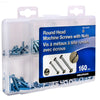When it comes to maintaining a healthy indoor environment, choosing the right furnace filter is crucial. Whether you're looking to improve air quality or enhance the efficiency of your heating system, understanding the differences between electrostatic and disposable furnace filters will help you make an informed decision.
Furnace filters are essential components of any home's HVAC system. They capture dust, allergens, and other airborne particles, ensuring the air circulating within your home is clean and breathable. In this blog post, we'll compare electrostatic and disposable filters, examining their advantages and disadvantages, and help you determine which type might be best suited for your needs.
Electrostatic Furnace Filters
Electrostatic filters use an innovative technology that employs self-charging fibers to attract and trap particles. Here's why you might consider them:
Advantages
-
Efficiency: Electrostatic filters are excellent at capturing small particles, such as smoke, pet dander, and pollen. They are known for their ability to significantly reduce airborne irritants quickly.
-
Reusability: Unlike disposable filters, electrostatic ones can be washed and reused multiple times, making them a more environmentally friendly choice.
-
Cost-effective Over Time: While the initial cost might be higher than disposables, their longevity can translate into savings in the long run.
Disadvantages
-
Maintenance: They require regular cleaning to maintain efficiency. Failing to clean them as required can reduce their effectiveness.
-
Initial Investment: The upfront cost is typically higher than that of disposable filters.
Disposable Furnace Filters
Disposable filters are widely used for their convenience and affordability. Let's explore why they might fit your needs:
Advantages
-
Ease of Use: Disposable filters are easy to replace, requiring no washing or maintenance. Once they are dirty, you simply replace them with a new one.
-
Initial Cost: These filters are generally inexpensive, with a lower upfront cost compared to electrostatic options.
Disadvantages
-
Environmental Impact: Since they are designed for single use, disposable filters produce more waste.
-
Long-term Cost: Over time, the cost of consistently replacing disposable filters can add up, potentially exceeding the cost of an electrostatic filter.
Which is Better?
Ultimately, the choice between electrostatic and disposable furnace filters depends on your individual priorities and lifestyle. If long-term costs and environmental sustainability are crucial to you, an electrostatic filter might be the better choice. If convenience and low upfront costs are more important, a disposable filter could be the way to go.
For further guidance on furnace filters and assistance in finding the right one for your HVAC system, feel free to explore the resources available at xpartsupply.com.
In conclusion, both electrostatic and disposable furnace filters have their unique benefits. By understanding their differences, you can make a well-informed decision that best suits your needs and contributes to a healthier home environment.







